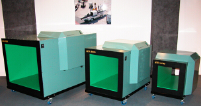June 3, 2003 – Magellan Technology of Sydney, Australia, has introduced more advanced versions of its large tunnel readers, which are built to read many tags on items moving along high-speed conveyor belts. They can be used to sort airline baggage, parcels and other items in industrial settings.
The three new readers are the MTRP 1080, MTRP 6060, MTRP 4040. They have openings of 3 by 2.4 feet (1 by 0.8 meter) 1.8 by 1.8 feet, (0.6 x 0.6 meter) and 1.2 by 1.2 feet (0.4 by 0.4 meter) respectively. Magellan, a technology developer, is licensing the designs to manufacturers who will sell them worldwide.
The tunnel readers can read from and write to tags regardless of their orientation. They all use the emerging 13.56 MHz international standard ISO 18000-3 Mode 2, which is in the final stages of approval. Magellan chose to use this protocol, according to Ken Laing, Magellan’s VP of marketing and business development, because it’s the only one that allows more than 10,000 tags to be read in the tunnel readers at the same time.
“ISO 18000-3 Mode 1 is very similar to the older and tired ISO 15693, whereas Mode 2 is a completely new protocol with much improved functionality and anti-collision performance,” Laing says. “These improvements are provided by the use of PJM (phase jitter modulation), frequency hopping tags and very high bit rates.”
Magellan designed the tunnel readers to be used as either standalone reader/programmers or as part of standard conveyor belt systems, which can be made of metal. They can read individual tags at a rate of up to 1,200 per second and work with conveyors using belt speeds of 1,000 feet per minute (5 meters per second).
The tunnel readers can identify the order of the tags at a belt speed of 500 feet per minute (2.5 meters per second) with a tag separation of about 3 inches (8 cm). This capability of the 18000-3 Mode 2 protocol is useful for sorting letters, parcels and items moving through a distribution center. Magellan also has also developed Item Tags, which cost about US$1 in simple adhesive paper packaging. The price falls to 57 cents when the tags are purchased in volume.
Magellan has also introduced a new tunnel reader that can read tags that are very close together. Normally, the tags interfere with one another, but Magellan says its tunnel reader can read 100 StackTags with a separation of less than one millimeter, or forty thousandths of an inch, in one second.
The new Magellan StackTag Reader Programmer (MSTRP 5050), has an opening of 1.5 by 1.5 feet (0.52 by 0.52 meter). The company says it can identify 1,200 articles with StackTags in less than one second. The reader can be used to identify stacked courier parcels even when tags are aligned one on top of another.
Laing says Magellan licensees are developing a variety of applications. In the diamond industry, the reader may be used to identify envelopes with small precious stones. The tags can be used in casinos to authenticate and count stacks of gambling chips, and they can sort stacks of medical files, legal documents and the like.
Magellan is currently establishing a network of partners and licensees worldwide. Present licensees include Infineon Technologies and Hoft & Wessel of Germany, Nippon Signal and Marubeni Corp. of Japan, Rafsec of Finland, and Scanology in Holland. Licensees set the pricing for the tunnel readers, but Laing says that in general, prices range from US$2,000 for the simplest to US$26,000 for the more robust and heavy duty industrial belt readers.
Less than two weeks left until the most important RFID conference of the year. Register today for RFID Journal Live!, Chicago from June 11 to 13.


